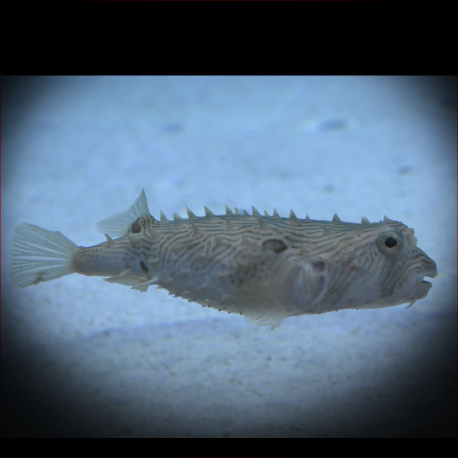More info
Datasheet
| Minimum Tank Size | 800 litres / 211.34 US gallons |
| Maximum Size | 28.0cm / 11.02inches |
| Reef Compatible | Reef safe with caution |
| Temperament | Aggressive towards other species |
| Temperature | 22.2°C / 71.96°F - 25.6°C / 78.08°F |
| Specific Gravity | 1.020-1.025 |
| Carbonate Hardness | 8-12 |
| pH | 8.1-8.4 |
General Description
The Striped burrfish, scientifically known as Chilomycterus schoepfii, belongs to the Diodontidae family, closely resembling pufferfish. These fish are characterized by their ability to puff themselves up, spikes, and unique way of swimming. In nature, they blow water into the sand to expose their food, earning them the nickname blowfish.
Aquarium Suitability
The Striped burrfish is considered suitable for aquariums with caution. While they have a fun and interesting personality, they are known to be aggressive towards other species, especially invertebrates like shrimps, crabs, crabs, small bivalves, sea urchins, and snails. They require a large tank of at least 800 liters due to their demands.
Demands, Care, and Hardiness
Porcupinefish are generally hardy fish, thriving under proper conditions and living for many years in captivity. They have specific feeding needs, requiring food that grinds their teeth as they continuously grow. Suitable options include snails or mussels, as fish flakes are not adequate for their dental health. Extra care is needed when handling or transporting them, as some species can release toxins when stressed.
Reef Suitability
The Striped burrfish is reef-safe with caution, as they are known to nibble on the fins of other fish in the aquarium. They do not thrive in the company of more aggressive fishes, which can stress them.
Aquarium Setup
When setting up an aquarium for Striped burrfish, it is crucial to provide hiding spots and adequate space for swimming. Care must be taken when placing electrical equipment, as these fish are known to blow water out of the tank during feeding.
Behaviour
Porcupinefish, like the Striped burrfish, exhibit an engaging personality, being playful and curious. They prefer being housed with their own species to reduce stress caused by more aggressive tank mates.
Feeding and Diet
The recommended diet for Striped burrfish includes larger crustaceans, other invertebrates, and small crustaceans like krill and mysis. Their food should help prevent their teeth from overgrowing, with clams being a suitable option.
Habitat and Distribution
Striped burrfish are found in the Western Atlantic from Nova Scotia, Canada, to Brazil, including regions like Maine (USA), the Bahamas, and the northern Gulf of Mexico. They are uncommon or absent from most of the West Indies.

